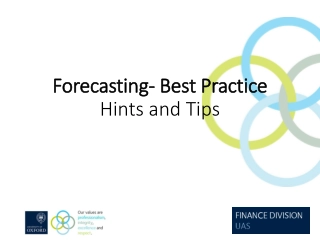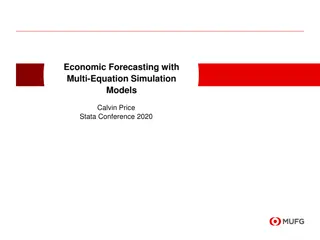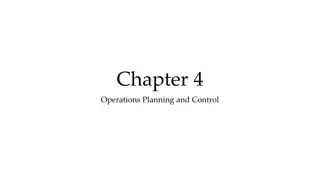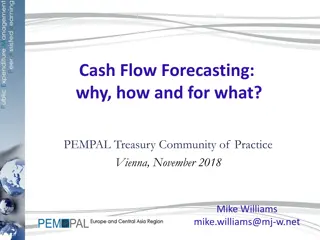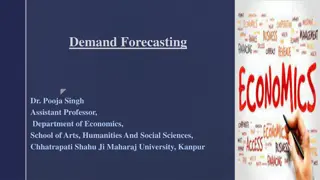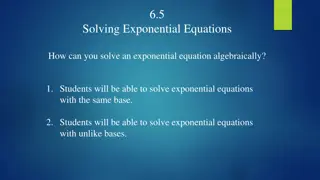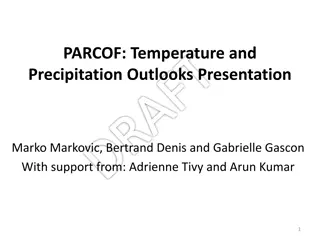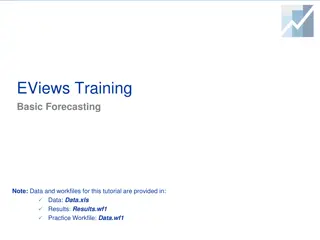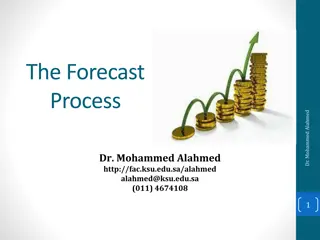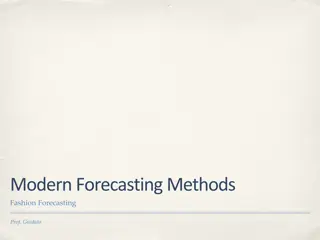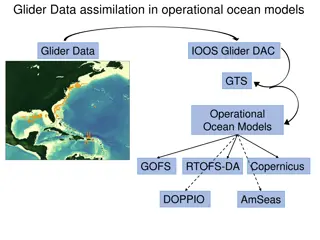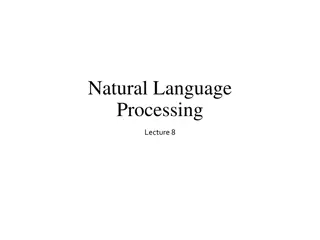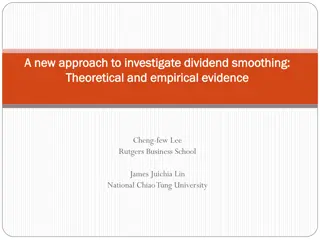Understanding Exponential Smoothing in Forecasting
Exponential smoothing is a popular method used in forecasting, where the most recent data is weighted the most. It involves a smoothing constant that ranges from 0 to 1, with little record-keeping of past data required. The method calculates new forecasts based on previous forecasts and actual demand. However, it may not be suitable for all situations, as seen in a check-processing center's case. Learn more about exponential smoothing through practical examples and problems provided.
Download Presentation

Please find below an Image/Link to download the presentation.
The content on the website is provided AS IS for your information and personal use only. It may not be sold, licensed, or shared on other websites without obtaining consent from the author. Download presentation by click this link. If you encounter any issues during the download, it is possible that the publisher has removed the file from their server.
E N D
Presentation Transcript
Chapter 4 Class 2
Exponential Smoothing Form of weighted moving average Weights decline exponentially Most recent data weighted most Requires smoothing constant ( ) Ranges from 0 to 1 Subjectively chosen Involves little record keeping of past data
Exponential Smoothing last period s forecast + (last period s actual demand last period s forecast) New forecast = Ft = Ft 1 + (At 1 - Ft 1) where Ft = new forecast Ft 1 = = previous forecast smoothing (or weighting) constant (0 1)
Exponential Smoothing Example Predicted demand = 142 Ford Mustangs Actual demand = 153 Smoothing constant = .20 New forecast = 142 + .2(153 142) = 142 + 2.2 = 144.2 144 cars
Problem 4.4 A check-processing center uses exponential smoothing to forecast the number of incoming checks each month. The number of checks received in June was 40 million, while the forecast was 42 million. A smoothing constant of .2 is used. A) What is the forecast for July? B) If the center received 45 million checks in July, what would be the forecast for August? C) Why might this be an inappropriate forecasting method for this situation?
Problem 4.4 A) What is the forecast for July? B) If the center received 45 million checks in July, what would be the forecast for August? C) Why might this be an inappropriate forecasting method for this situation?
Problem 4.18 Consider the following actual (At) and forecast (Ft) demand levels for a product. The first forecast, F 1 , was derived by observing A 1 and setting equal to A 1 . Subsequent forecast averages were derived by exponential smoothing. Using the exponential smoothing method, find the forecast for time period 5
Problem 4.18 We need to find the smoothing constant . We know in general that Ft = Ft 1 + (At 1 Ft 1); t = 2, 3, 4. Choose either t = 3or t = 4(t = 2won t let us find because F2 = 50 = 50 + (50 50) holds for any ). Let s pick t = 3. Then F3 = 48 = 50 + (42 50) or 48 = 50 + 42 50 or 2 = 8 So, .25 = Now we can find F5 :F5 = 50 + (46 50) F5 = 50 + 46 50 = 50 4 For = .25, F5 = 50 4(.25) = 49 The forecast for time period 5 = 49 units.
Common Measures of Error Mean Absolute Deviation (MAD) |actual - forecast| MAD = n Mean Squared Error (MSE) (forecast errors)2 MSE = n
Common Measures of Error Mean Absolute Percent Error (MAPE) n 100 |actuali - forecasti|/actuali i = 1 MAPE = n
Comparison of Forecast Error Rounded Forecast with = .10 Absolute Deviation for = .10 Rounded Forecast with = .50 Absolute Deviation for = .50 Quarter Actual Tonnage Unloaded 1 2 3 4 5 6 7 8 180 168 159 175 190 205 180 182 175 176 175 173 173 175 178 178 5 8 175 178 173 166 170 180 193 186 5 10 14 16 2 17 30 2 4 84 9 20 25 13 4 100
Comparison of Forecast Error |deviations| Rounded Forecast with = .10 Absolute Deviation for = .10 Rounded Forecast with = .50 Absolute Deviation for = .50 MAD = Quarter Actual Tonage Unloaded For = .10 n 1 2 3 4 5 6 7 8 180 168 159 175 190 205 180 182 175 176 175 173 173 175 178 178 5 8 175 178 173 166 170 180 193 186 5 = 84/8 = 10.50 10 14 16 2 17 30 2 4 84 For = .50 9 20 25 13 = 100/8 = 12.50 4 100
Comparison of Forecast Error (forecast errors)2 Rounded Forecast with = .10 Absolute Deviation for = .10 Rounded Forecast with = .50 Absolute Deviation for = .50 MSE = Quarter Actual Tonage Unloaded For = .10 n 1 2 3 4 5 6 7 8 180 168 159 175 190 205 180 182 175 176 175 173 173 175 178 178 5 8 175 178 173 166 170 180 193 186 5 = 1,558/8 = 194.75 10 14 16 2 17 30 2 4 84 For = .50 9 20 25 13 = 1,612/8 = 201.50 4 100 MAD 10.50 12.50
Comparison of Forecast Error 100 |deviationi|/actuali i = 1 n Rounded Forecast with = .10 Absolute Deviation for = .10 Rounded Forecast with = .50 Absolute Deviation for = .50 MAPE = Quarter Actual Tonage Unloaded For = .10 n 1 2 3 4 5 6 7 8 180 168 159 175 190 205 180 182 175 176 175 173 173 175 178 178 5 8 175 178 173 166 170 180 193 186 5 = 45.62/8 = 5.70% 10 14 16 2 17 30 2 4 84 For = .50 9 20 25 13 = 54.8/8 = 6.85% 4 100 MAD MSE 10.50 194.75 12.50 201.50
Comparison of Forecast Error Rounded Forecast with = .10 Absolute Deviation for = .10 Rounded Forecast with = .50 Absolute Deviation for = .50 Quarter Actual Tonnage Unloaded 1 2 3 4 5 6 7 8 180 168 159 175 190 205 180 182 175 176 175 173 173 175 178 178 5 8 175 178 173 166 170 180 193 186 5 10 14 16 2 17 30 2 4 84 9 20 25 13 4 100 MAD MSE MAPE 10.50 194.75 5.70% 12.50 201.50 6.85%
Problem 4.14 following are two weekly forecasts made by two different methods for the number of gallons of gasoline, in thousands, demanded at a local gasoline station. Also shown are actual demand levels in thousands of gallons: What are the MAD and MSE for each method?
Problem 4.14 What are the MAD and MSE for each method? Method 1: MAD: (0.20 + 0.05 + 0.05 + 0.20)/4 = .125 MSE : (0.04 + 0.0025 + 0.0025 + 0.04)/4 = .021 Method 2: MAD: (0.1 + 0.20 + 0.10 + 0.11) / 4 = .1275 MSE : (0.01 + 0.04 + 0.01 + 0.0121) / 4 = .018
Exponential Smoothing with Trend Adjustment When a trend is present, exponential smoothing must be modified Forecast including (FITt) = trend exponentially smoothed (Ft) + forecast (Tt) smoothed trend exponentially
Exponential Smoothing with Trend Adjustment Ft = (At - 1) + (1 - )(Ft - 1 + Tt - 1) Tt = (Ft - Ft - 1) + (1 - )Tt - 1 Step 1: Compute Ft Step 2: Compute Tt Step 3: Calculate the forecast FITt = Ft + Tt
Exponential Smoothing with Trend Adjustment Example Forecast Including Trend, FITt 13.00 Month(t) 1 2 3 4 5 6 7 8 9 10 Actual Demand (At) 12 17 20 19 24 21 31 28 36 Smoothed Forecast, Ft 11 Smoothed Trend, Tt 2 Table 4.1
Exponential Smoothing with Trend Adjustment Example Forecast Including Trend, FITt 13.00 Month(t) 1 2 3 4 5 6 7 8 9 10 Actual Demand (At) 12 17 20 19 24 21 31 28 36 Smoothed Forecast, Ft 11 Smoothed Trend, Tt 2 Step 1: Forecast for Month 2 F2 = A1 + (1 - )(F1 + T1) F2 = (.2)(12) + (1 - .2)(11 + 2) = 2.4 + 10.4 = 12.8 units Table 4.1
Exponential Smoothing with Trend Adjustment Example Forecast Including Trend, FITt 13.00 Month(t) 1 2 3 4 5 6 7 8 9 10 Actual Demand (At) 12 17 20 19 24 21 31 28 36 Smoothed Forecast, Ft 11 12.80 Smoothed Trend, Tt 2 Step 2: Trend for Month 2 T2 = (F2 - F1) + (1 - )T1 T2 = (.4)(12.8 - 11) + (1 - .4)(2) = .72 + 1.2 = 1.92 units Table 4.1
Exponential Smoothing with Trend Adjustment Example Forecast Including Trend, FITt 13.00 Month(t) 1 2 3 4 5 6 7 8 9 10 Actual Demand (At) 12 17 20 19 24 21 31 28 36 Smoothed Forecast, Ft 11 12.80 Smoothed Trend, Tt 2 1.92 Step 3: Calculate FIT for Month 2 FIT2 = F2 + T1 FIT2 = 12.8 + 1.92 = 14.72 units Table 4.1
Exponential Smoothing with Trend Adjustment Example Forecast Including Trend, FITt 13.00 14.72 17.28 20.14 22.14 24.89 26.18 29.59 31.60 35.16 Month(t) 1 2 3 4 5 6 7 8 9 10 Actual Demand (At) 12 17 20 19 24 21 31 28 36 Smoothed Forecast, Ft 11 12.80 15.18 17.82 19.91 22.51 24.11 27.14 29.28 32.48 Smoothed Trend, Tt 2 1.92 2.10 2.32 2.23 2.38 2.07 2.45 2.32 2.68 Table 4.1
Exponential Smoothing with Trend Adjustment Example 35 Actual demand (At) 30 25 Product demand 20 15 Forecast including trend (FITt) 10 5 0 | | | | | | | | | 1 2 3 4 5 6 7 8 9 Time (month) Figure 4.3
Problem 4.19 Income at the law firm of Smith and Wesson for the period February to July was as follows: Month Income (In $ thousand) FEB 70.0 MAR APR 68.5 MAY JUNE JUL 71.7 71.3 64.8 72.8 Use trend-adjusted exponential smoothing to forecast the law firm s August income. Assume that the initial forecast for February is $65,000 and the initial trend adjustment is 0.The smoothing constants selected are = 0.1 and =0.2
Trend Projections Fitting a trend line to historical data points to project into the medium-to-long-range Linear trends can be found using the least squares technique ^ y = a + bx ^ where y = computed value of the variable to be predicted (dependent variable) a = y-axis intercept b = slope of the regression line x = the independent variable
Least Squares Method Actual observation (y value) Deviation7 Values of Dependent Variable Deviation5 Deviation6 Deviation3 Deviation4 Deviation1 Deviation2 ^ Trend line, y = a + bx Time period Figure 4.4
Least Squares Method Actual observation (y value) Values of Dependent Variable Deviation7 Deviation5 Deviation6 Least squares method minimizes the sum of the Deviation3 Deviation4 squared errors (deviations) Deviation1 Deviation2 ^ Trend line, y = a + bx Time period Figure 4.4
Least Squares Method Equations to calculate the regression variables ^ y = a + bx xy - nxy x2 - nx2 b = a = y - bx
Least Squares Example Time Period (x) Electrical Power Demand x2 Year xy 1999 2000 2001 2002 2003 2004 2005 1 2 3 4 5 6 7 74 79 80 90 105 142 122 1 4 9 74 158 240 360 525 852 854 16 25 36 49 x2 = 140 x = 28 x = 4 y = 692 y = 98.86 xy = 3,063 3,063 - (7)(4)(98.86) xy - nxy b = x2 - nx2 = 140 - (7)(42) = 10.54 a = y - bx = 98.86 - 10.54(4) = 56.70
Least Squares Example Time Period (x) Electrical Power Demand x2 Year xy 1999 2000 2001 2002 2003 2004 2005 1 2 3 4 5 6 7 74 79 80 90 105 142 122 1 4 9 74 158 240 360 525 852 854 The trend line is 16 25 36 49 ^ y = 56.70 + 10.54x x2 = 140 x = 28 x = 4 y = 692 y = 98.86 xy = 3,063 3,063 - (7)(4)(98.86) xy - nxy b = x2 - nx2 = 140 - (7)(42) = 10.54 a = y - bx = 98.86 - 10.54(4) = 56.70
Least Squares Example Trend line, y = 56.70 + 10.54x ^ 160 150 140 130 120 110 100 90 80 70 60 50 Power demand | | | | | | | | | 1999 2000 2001 2002 2003 Year 2004 2005 2006 2007
Least Squares Requirements 1. We always plot the data to insure a linear relationship 2. We do not predict time periods far beyond the database 3. Deviations around the least squares line are assumed to be random
Problem 4.25 The following gives the number of accidents that occurred on Florida State Highway 101 during the last 4 months: Month Number of Accidents January 30 February 40 March 60 April 90 Forecast the number of accidents that will occur in May, using least squares regression to derive a trend equation.


